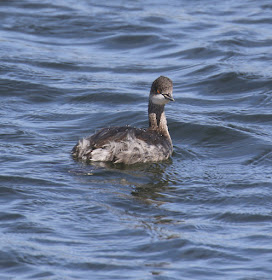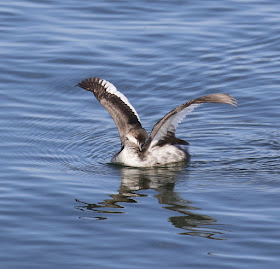Farmoor Reservoir maintains its good run of birds and today with the continuing sunshine Farmoor's waters were again a deep blue, traversed by white sailed yachts, allowing my imagination to almost convince me that I was at a sunny coastal resort rather than an artificial body of water about as far inland as one can be.
This matters not one jot of course to tired migrant waders and waterbirds of various sorts and today the reservoir was harbouring two scarce visitors in the form of a juvenile Red necked Grebe and a Black necked Grebe, both of which have been here for a few days.
Arriving at the reservoir around lunchtime I walked up to the tarmac pathway that circumvents Farmoor Two, the larger of the two reservoirs and instead of making for the central causeway turned left and set off on the long walk around Farmoor Two in search of the grebes that I knew were somewhere on the south western side of the reservoir. I walked the western side but found nothing there apart from a Common Sandpiper feeding along the concrete apron with some Pied Wagtails for company. Carrying on to the southern side, about half way along I came across the juvenile Red necked Grebe feeding close in to the wall. This continues a remarkable sequence of visits to the reservoir by this species in the last two years, with an adult appearing and remaining for a long period both in the autumn and spring of those years and even a juvenile paid a one day visit on this date in September of last year.
After taking some pictures I decided to also partake of some rest and relaxation and sat on the retaining wall and watched the grebe. I have developed more than a little enthusiasm for watching bird behaviour and appearance as there is always something to learn, some aspect I have never seen or noticed before and I take great delight in noting the shapes and profiles birds create when going about their lives, be it in this case diving for food, preening, or just doing nothing much. So I watched the young grebe floating on the blue waters of the reservoir and recorded some of the images and profiles it presented from various angles.
The main thing that stuck in my mind was the image it presented either from head on or when viewed from behind. On the rear of its crown there were individual tufts of black feathers either side of its head which extended slightly outwards making it look for all the world like it was wearing one of those silly little black hats matadors in Spain wear when they are in a bullring. I had not noticed this feature before on the recent sequence of annual visits by Red necked Grebes to the reservoir. This probably says more about my powers of observation but this is the benefit of having a camera of some sort, which everyone has these days. Little aspects un-noticed at the time can be reviewed later in the comfort of one's home and studied in as much detail as one would want to go into. So there are benefits to camera's apart from obtaining that ultimate shot of a bird posing full frame and I confess to getting just as much pleasure recording such images as I do the more traditional ones.
The grebe was diving and swimming near to a couple of Coots who were so engrossed in nibbling each other's head feathers and generally carrying on like a newly besotted couple that nothing could distract them from their ardour. The gentle caressing and bonding went on for some time but I was unaware that Coots form pairs in the autumn. Perhaps these two were an exception or the ardour was brought on by the current exceptionally fine weather. Being Coots they did of course occasionally slip into their bad old ways, finding it irresistible to administer the occasional peck at each other but for the most part you could not have asked for a more passionate demonstration of mutual affection and tenderness.This was such a contrast to the normally constant bickering and belligerent behaviour that Coots usually delight in.
The numbers of Coot on the reservoir are building up now as more and more arrive to spend the winter months. It's a paradox that such an anti social bird chooses to flock together in winter and there are virtually constant minor squabbles between the occupants of these flocks but they persist in flocking presumably based on the fact it is beneficial to put up with the close proximity of others of their kind due to the comparative safety that numbers can bring.
I walked on as my next grebe species was keenly anticipated. It was a Black necked Grebe which had arrived a day after the Red necked Grebe and was now happily ensconced on the reservoir further along the southern bank. Tiny, rotund and not much bigger than a Little Grebe it finally revealed itself after a short search, close into the concrete banking, Unprepossessing in plumage, being basically brown, grey and dull white its only striking feature was its livid red eye, staring fiercely almost satanic in the bright sunlight.
I watched it diving and followed as it moved up and down just offshore. Then it ceased feeding and commenced bathing and preening, something I have never seen a Black necked Grebe do before. Not because they do not but because my opportunities to even see a Black necked Grebe, let alone sit and watch one closely for an hour or so, have been few and far between.
It was a bravura performance as it commenced vigorously thrashing the water with its wings, creating quite a stir, throwing spray and droplets of water in all directions presumably to cover all its upperpart feathers. It gyrated in the water, splashing away and would then crash dive and disappear underwater only to rise again after ten or so seconds, bobbing up like a cork and able to stand in the water due to the position of its feet far back on its body, then float seemingly content or exhausted with its efforts for a minute or two, its head sunk into its body and assuming the compact proportions and imagery of the proverbial rubber duck that floats in the proverbial bath.
This did not last long before it would be seized by another frenzy and repeated the wing beating, splashing and crash dive. This sequence was repeated numerous times and inevitably attracted the attention of those perennial nosy parkers, Coots, but they soon lost interest and the grebe only showed mild wariness and no real signs of alarm at the close presence of the larger Coot.
There was an occasion when it decided to scratch its head with its enormous palmate toes that serve to propel it through the water. Not an easy exercise to accomplish with such unwieldy appendages and it also provided a graphic illustration of how far back the legs and feet are situated on its body to give it maximum propulsion and manoeuvrability in the water.
Finally it ceased its diving and wing extending and settled to just preening as it floated on the water.
This was my cue to walk on, musing on not only the pleasure of seeing two unusual grebe species close up and for an extended period but also to having seen and learnt just a little bit more about both grebes.
This was my cue to walk on, musing on not only the pleasure of seeing two unusual grebe species close up and for an extended period but also to having seen and learnt just a little bit more about both grebes.











































No comments:
Post a Comment